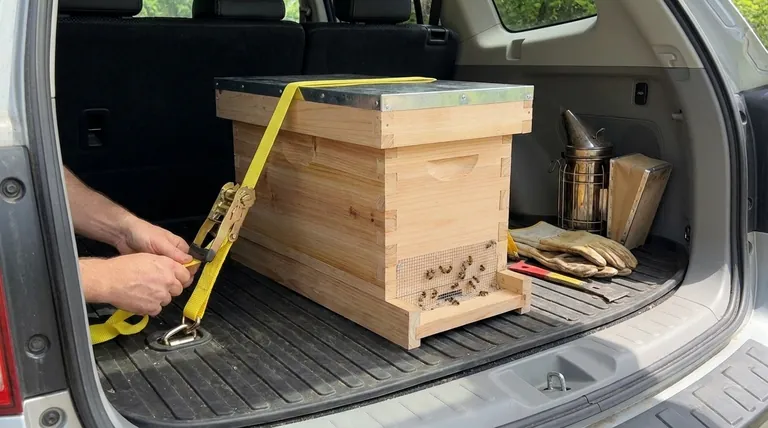In short, securely fastening a nucleus hive (nuc) in your vehicle is essential for two primary reasons: it ensures your safety as the driver and significantly reduces stress on the bees, which is critical for their health and the colony's successful establishment.
The core issue isn't just about preventing a box from tipping over. It's about managing risk—to yourself, to the public, and to the bees themselves. An unsecured nuc is a container of thousands of stressed, defensive insects in an enclosed space with you.

The Risks of an Unsecured Nuc
Transporting bees is one of the more hazardous aspects of beekeeping, especially for new hobbyists. Understanding the specific risks involved clarifies why security is non-negotiable.
Risk 1: Driver and Public Safety
An unsecured nuc can easily tip over or slide during a sudden stop, a sharp turn, or even from simple road vibrations.
This can break the seal of the nuc box, releasing thousands of disoriented and defensive bees inside your vehicle. A cabin full of stinging insects creates an extremely dangerous driving situation, risking a serious accident.
Risk 2: Bee Stress and Absconding
Bees are sensitive to vibration and movement. The journey in a vehicle is an inherently stressful experience for them.
Excessive jostling increases their agitation, raises the internal temperature of the nuc, and can cause them to consume their stored honey reserves rapidly. Highly stressed bees are more likely to abscond (abandon the hive) once you install them.
Risk 3: Damage to the Colony
A sudden shift can cause the frames inside the nuc to crash into each other. This can damage delicate comb, kill brood (bee larvae and pupae), and potentially injure or kill the queen.
Losing the queen or a significant amount of brood can set the colony back weeks or even cause it to fail entirely.
Understanding the Trade-offs
While it may seem faster to just place the nuc on a seat or floor, this is a classic example of a false economy.
Perceived Benefit: Speed and Convenience
The only "benefit" to not securing a nuc is saving a few minutes. This convenience is an illusion that evaporates the moment something goes wrong.
The Inescapable Cost: High Consequence of Failure
The potential consequences—a car accident, a failed colony, or both—are severe. The minor upfront effort to secure the nuc with a strap or by wedging it in place is an essential insurance policy against a catastrophic outcome.
How to Secure Your Nuc Properly
Your goal is to make the nuc an immovable part of the vehicle, minimizing vibration and eliminating the possibility of it shifting or tipping.
Choose the Right Location
The best spot is often on the floor, where the center of gravity is lowest. A trunk or the cargo area of an SUV is also a good choice, as it separates you from the bees. Avoid placing it high up on a seat where it's more likely to tip.
Use Straps or Wedges
A ratchet strap or cam buckle strap is the ideal tool. Loop it over the nuc and secure it to anchor points in the vehicle. If you don't have straps, firmly wedge the nuc in place with other heavy, stable items so it cannot move in any direction.
Ensure Ventilation
Bees generate significant heat, especially when stressed. Make sure the nuc's ventilation screens are clear and not blocked by straps or other objects. On warm days, use your vehicle's air conditioning to help keep the ambient temperature cool.
Making the Right Choice for Your Goal
Transporting bees is not just about moving a box; it's about safeguarding your investment and your own well-being.
- If your primary focus is personal safety: Always use straps to firmly anchor the nuc, preventing any movement that could release bees inside your vehicle.
- If your primary focus is colony health: Secure the nuc on the floor to minimize vibration and prevent frame damage, ensuring the bees arrive calm and ready to thrive.
Properly securing your nuc transforms a high-risk activity into a simple, safe, and routine part of beekeeping.
Summary Table:
| Risk Factor | Key Consequence |
|---|---|
| Driver/Public Safety | Unsecured nuc can release bees, causing a dangerous driving situation and potential accident. |
| Bee Stress & Absconding | Excessive movement agitates bees, raising hive temperature and increasing the risk of colony abandonment. |
| Colony Damage | Shifting frames can kill brood, injure the queen, and set the colony back by weeks or cause failure. |
Transport your bees with confidence and care. For commercial apiaries and distributors, a successful season starts with safe bee transport. HONESTBEE supplies the durable, high-quality beekeeping equipment and supplies you need to operate safely and efficiently at scale. Let us help you protect your valuable colonies. Contact our wholesale experts today to discuss your equipment needs.
Visual Guide

Related Products
- 5 Frame Wooden Nuc Box for Beekeeping
- HONESTBEE Advanced Ergonomic Stainless Steel Hive Tool for Beekeeping
- HONESTBEE Professional Multi-Functional Hive Tool with Ergonomic Wood Handle
- HONESTBEE Professional Long Handled Hive Tool with Precision Cutting Blade
- Honey Flow Garden Bee Hive Flow Hive Best Beehive for Beginners
People Also Ask
- What are the benefits of using nucs for beginning beekeepers? Ensure a Successful First Hive with a Head Start
- How should the nuc be installed in the apiary? Ensure Colony Success from Day One
- What frames should be moved into the queenless hive when requeening with a nuc? Ensure a Successful Queen Introduction
- What is a common feature of many 5-frame nuc boxes? The Integrated Feeder for Efficient Colony Growth
- What is the advantage of overwintering a nucleus? A Strategic Asset for Beekeeping Success



















